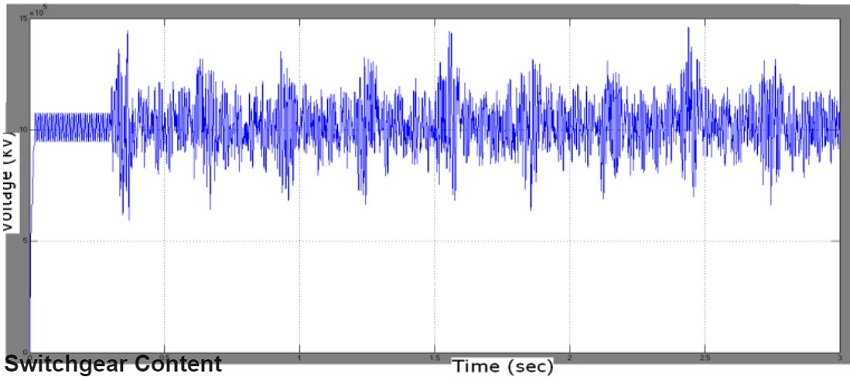
- Steep wave front, for which the rise time is usually 2–20 ns: when re striking occurred to the contact clearance of disconnector, the arc striking process is very rapid; thus, the voltage waveform that injected into the network has very high ascending or descending steepness.
- Theoretically, the amplitude of VFTO can be up to 3.0 p.u. This extreme condition is generated when the polarities of voltage on both sides of the branch being open are reverse and both are the maximum values. Considering the actual reasons, such as residual voltage, damping and attenuation, the VFTO obtained in actual measurement or simulation test does not exceed 2.0 p.u. in most cases. Considering the worst case, the maximum overvoltage can be up to about 2.5–2.8 p.u.
- The VFTO has a lot of high-frequency components, within the range of 30kHz–100MHz. This is because that GIS uses SF6 gas as the medium, with insulation strength well above that of air.
- VFTO is closely related to the restriking and arc quenching moments of GIS disconnector and position of the disconnector nodes in GIS equipment.
Pic show a example of VFTO waveform in 750 KV GIS.




Fascinating. Can you explain a little more on the reasons for such a high PU level? 3.0 PU is a very large overvoltage. In the USA, I wonder how often engineers incorporate this in their Minimum Approach Distance calculations per our OSHA requirements. Thanks for sharing this info – great stuff!
Thank you for your comment.
In high voltage GIS when the disconnector in the gas insulated substation meets the small capacitance current, it will produce a strong transient signal with large amplitude (up to 3 pu) and high frequency (up to 100 MHz). At the same time, the wave head steepness of the signal is very large, and the wave front time is about ns level (3~100 ns).
The Very Fast Transients (VFT) in power systems cover a frequency range from 100 kHz up to hundreds of MHz. VFT is an effect of GIS disconnector opening or closing, as well as other events such as the operation of a circuit breakers or grounding switches. An electromagnetic wave is generated, which propagates along the busbars and substation apparatus. Due to the fact that in can be multiple times reflected at joints between substation equipment, its maximum overvoltage peak values can reach significant levels. Their magnitude is in the range of 1.5 to 2.0 p.u. of the line-to-neutral voltage crest, but they can also reach values as high as 2.5 p.u. to 3 p.u. in case of ultra high voltage systems. These values are generally below the Basic Insulation Level (BIL), but VFT can speed up insulations aging and degradation processes due to their frequent occurrences.
Nice article. Why the VFTO is not occuring on AIS? In AIS also the same disconnector operation happens, but the VFTO study is not done. Please explain.
The phenomenon VFTO mostly occurs in GIS. One of the reasons is the fast switching of disconnectors.